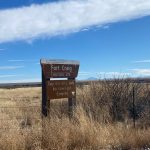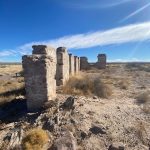Symposium Spotlight: Phill Greenwalt Visits Fort Craig
With less than three months remaining until our symposium, several of our authors will further explore topics relating to their ‘What If’ theme. Today, Phill Greenwalt explores Fort Craig, New Mexico…
In 1853, soldiers of the 3rd United States Infantry arrived on a bluff in southcentral New Mexico Territory along the Rio Grande. Their task was to construct a fort to replace Fort Conrad, located nine miles upriver but was sited in place prone to flooding which caused a series of construction issues.
The new fort, named after Captain Louis S. Craig, an army officer that was killed by deserters in California in 1852, the fort was completed enough to be garrisoned by 1854. Seven years later, in July 1861, near the start of the American Civil War, Fort Craig had swelled into the largest garrisoned military installation in the southwest United States with an occupying force of approximately 2,000 men.
Along with seven other forts that guarded the pivotal north-south road in the Rio Grande Valley, Craig became the headquarters of Colonel Edward Canby who assumed command of United States forces in June 1861. When the Confederates launched their largest invasion of the territory under Brigadier General Henry Hopkins Sibley in early 1862, Fort Craig was one of the objectives.
Unfortunately for the Confederates the forts adobe walls were too thick and impenetrable for the lighter artillery pieces they carried. In the attempt to maneuver Federal forces out of the stronghold, an engagement erupted six miles north of Fort Craig at Valverde Ford on February 20-21, 1826. Although a Confederate victory, Federal forces were able to retreat back to Craig, prompting Sibley to alter his plan to capture the fort and instead head north to Albuquerque and Santa Fe in search of supplies.
From 1863 to 1865 Fort Craig was the staging area for incursions against Native Americans in the region. This included campaigns in later years against notable Native American warriors and chiefs such as Geronimo and Victorio.
Besides Native American and Civil War history, the fort also housed units of Buffalo Soldiers and the famed American frontiersman, Kit Carson when he commanded a New Mexico infantry regiment during the war.
Twenty years after the conclusion of the American Civil War the fort was completely abandoned by the United States Army in 1885. In 1981 the land and fort was transferred to the Bureau of Land Management which operates a small visitor center and protects the ruined fort to this day.
Although in ruins now, the fort was a major obstacle that had to be navigated by Sibley’s Confederates during February of 1862 yet posed another “what if” which will be discussed at this year’s Emerging Civil War symposium.
Find more information on our 2022 Symposium, and purchase tickets, by clicking here. Ticket quantities are limited!






I’ve driven close to Ft. Craig, but was unable to visit it. It’s not too far from the Trinity site. New Mexico is beautiful, but the whole New Mexico campaign must have been very rough for all involved.